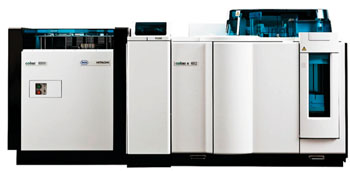Novel Method Detects Bacterial Infection in Preterm Infants
By LabMedica International staff writers
Posted on 12 Apr 2016
A new criterion has been proposed for diagnosis of bacterial infection in preterm infants and using this method could lead to early diagnosis and treatment for bacterial infection and improve the prognosis for preterm infants.Posted on 12 Apr 2016
Infants born prematurely do not have fully developed immune functions and compared to full-term infants, and if preterm infants suffer a bacterial infection there is a higher chance of fatality or negative impact on future growth and development.

Image: The cobas 8000 modular analyzer system (Photo courtesy of Roche Diagnostics).
Scientists at Kobe University (Japan) examined 1,267 serums from 283 newborns at the neonatal intensive care unit in Kobe University Hospital between June and December 2014. The enrolled newborns were divided into three infant groups as follows: 37 preterm of less than 34 weeks’ gestational age (GA); 61 late preterm of 34 to 36 weeks’ GA, and 185 term infants equal to or greater than 37 weeks’ GA.
Serum procalcitonin (PCT), was used as a marker used for early detection of bacterial infection in adults and children. Serum PCT measurement was performed using 30 μL of serum, the serum PCT concentration was measured by electrochemical luminescence immunoassay using the COBAS 8000e analyzer (Roche Diagnostics, Basel, Switzerland). The results demonstrated that PCT levels in full-term infants rose temporarily one day after birth, returning to the normal level for adults within five days (0.1ng/mL). However, for preterm infants it took nine days after birth for PCT to return to normal levels. Based on these results, the group plotted two reference curves: 50th percentile and 90th percentile values. When they superimposed three cases of preterm infants with bacterial infection on these curves, it clearly showed that in all three cases the serum PCT concentrations were higher than the 95th percentile values.
The authors concluded that that the physiological feature in preterm infants was significantly different from that in late preterm infants, even in those less than 37 weeks’ gestational age. To detect late-onset bacterial infection and sepsis, an age-specific percentile-based reference curve may be useful in preterm infants. Ichiro Morioka, MD, a professor of pediatrics and senior author of the study said, “We could also potentially use this method to limit unnecessary use of antibacterial agents. Our next step is to verify the precision of diagnoses based on these reference curves.” The study was published on April 1, 2016, in the journal Scientific Reports.
Related Links:
Kobe University
Roche Diagnostics













